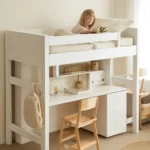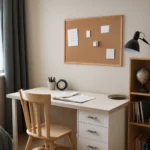In designing the perfect study space, both high school and elementary school room interiors have their unique needs. Creating a balanced environment that fosters focus, creativity, and comfort is crucial for students of all ages. This article explores various design elements, from furniture choices to layout ideas, that can help create a productive and comfortable study space for students.
Looking to design a high school room interior desk, elementary school study room interior, or general room interior? Here are practical ideas and tips to make the most of any study space. Why is the desk layout so important? Find out now!
High School Room Interior Desk: A Blend of Functionality and Aesthetic
When considering a high school student’s room, the desk is undeniably the centerpiece. This piece of furniture doesn’t just hold books and assignments, but it shapes the study habits and organization of the student. High school students benefit from a desk layout that’s both functional and inviting.
What Makes a High School Room Desk Stand Out?
The perfect high school room interior desk is one that blends minimalism with functionality. For instance, desks that feature built-in storage can help students keep their materials organized and within reach. A tidy space can directly impact a student’s ability to concentrate and feel motivated. Whether it’s a simple wooden desk or one with multiple drawers, the right desk setup will make a difference.
For the high school student, the desk should also consider ergonomics. A comfortable chair and a desk at the right height can prevent fatigue and promote good posture, which is especially important as students spend extended hours studying or completing assignments. Additionally, it’s wise to include natural light or adjustable lighting to reduce eye strain.
Here are a few features that can elevate the desk space:
-
Built-in storage Drawers or shelves can keep stationery, books, and gadgets organized.
-
Task lighting Desk lamps that can adjust to provide ample lighting are essential.
-
Personal touches A photo frame, plant, or inspirational quotes can make the desk space feel personal and motivating.
Real-Life Example
Consider Emma, a high school senior, who recently redesigned her study desk to be more efficient. By adding shelving for textbooks, installing a task lamp, and using drawer organizers for stationery, she noticed a significant boost in her productivity and focus. Emma’s workspace now feels more like a professional environment, which also helps her adopt a more serious approach to her studies.
Elementary School Study Room Interior: Fun and Functional Spaces for Young Learners
Designing an elementary school study room interior is all about striking a balance between fun, creativity, and practicality. A study room for younger students must be engaging without being distracting. Bright colors, comfortable furniture, and easy access to learning tools are key.
Key Features of an Elementary School Study Room
Young children need a study space that feels inviting and playful while still promoting concentration. Bright, cheerful colors like yellow or blue can add an element of fun to the room, while avoiding overly loud patterns that might disrupt focus. A desk that’s appropriately sized for a child’s age is important for both comfort and functionality.
In addition to a desk, the inclusion of a cozy reading nook or interactive learning boards can encourage breaks and enhance the child’s overall learning experience. Open shelving for books and learning supplies can help kids easily access materials while encouraging organization.
Here are some suggestions for making an elementary study space work:
-
Ergonomic, child-sized furniture Ensure the desk and chair are at the right height for the child.
-
Colorful and fun decor A mix of educational posters and playful designs can brighten up the space.
-
Interactive elements Chalkboards, dry-erase boards, or whiteboards can engage the child and keep them focused.
Real-Life Example
Lucas, a 9-year-old, loves his newly designed study room, which includes a colorful bookshelf, a cozy beanbag chair, and a small wooden desk. His mom added educational posters on the walls, and Lucas now looks forward to his study sessions. The environment is vibrant yet organized, promoting both fun and focus.
Elementary School Room Interior: Designing a Comfortable and Productive Space
For younger children, the overall layout of a classroom or room interior needs to be designed to be both practical and stimulating. Incorporating spaces for play, rest, and focused learning can help develop both cognitive and social skills.
The Elements of an Ideal Elementary Room Interior
Unlike high school rooms, where students need a more structured and focused environment, elementary school rooms should encourage creativity and engagement. The addition of vibrant colors, flexible seating, and designated areas for different activities can transform a classroom or study space into a dynamic, inspiring environment.
-
Bright colors and themes Walls can be painted in soft, inviting colors that promote calm, while allowing for creative decorations and learning aids.
-
Flexible seating Chairs and desks that are movable allow students to change positions and work together in groups, encouraging collaboration.
-
Storage solutions Shelves, cubbies, and bins are essential for keeping toys, art supplies, and learning materials neatly organized.
Real-Life Example
In an elementary school, the teacher decided to redesign the classroom to make it more student-friendly. She created designated zones for reading, group work, and independent study. The use of adjustable seating and soft lighting helped create a comfortable atmosphere, where kids felt motivated and relaxed. This shift led to better focus during class time and a more productive learning environment.
Conclusion
Designing the right study space, whether for a high school room interior desk or an elementary school study room interior, is essential for fostering a productive and comfortable learning environment. Both high school and elementary room interiors need to consider functionality, organization, and personalization to meet the needs of students. By incorporating elements such as ergonomic furniture, task lighting, and interactive learning tools, students of all ages can create a space that encourages both study and creativity.
Creating a room that reflects the student’s personality while also promoting productivity can make a significant difference in their daily routine. Investing in the right furniture, colors, and layout choices can help nurture the learning habits that lead to success.






